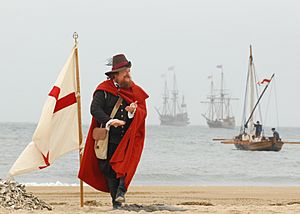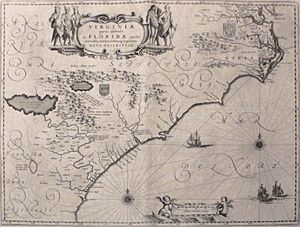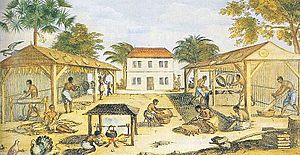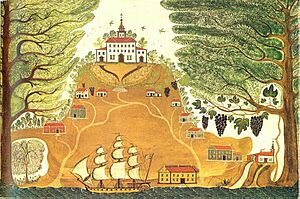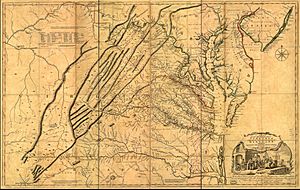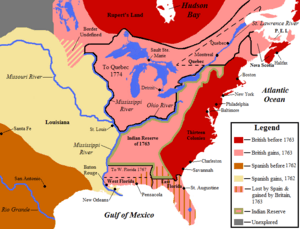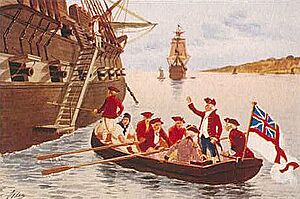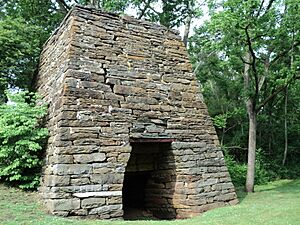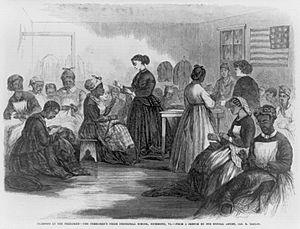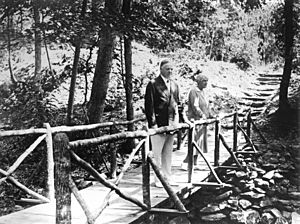History of Virginia facts for kids
The History of Virginia is a fascinating story that began long before Europeans arrived. Native American groups like the Algonquian, Iroquoian, and Siouan peoples lived here for thousands of years. The first Europeans to explore the area were Spanish in the 1500s. Later, English settlers tried to start a colony in the 1580s, but it didn't work out.
Permanent English settlement began in 1607 at Jamestown. The early colonists faced many challenges, including starvation. The colony finally succeeded when they started growing tobacco, which became a very profitable crop. This led to the use of indentured servants and, later, enslaved people from West Africa to work on large farms called plantations.
Virginia became the richest and most populated British colony in North America. It had an elected government called the General Assembly. Important Virginians played a big role in the American Revolution, helping to write the Declaration of Independence and the Bill of Rights. Four of the first five U.S. presidents were from Virginia: George Washington, Thomas Jefferson, James Madison, and James Monroe.
In the 1800s, tobacco farming changed, and Virginia's economy shifted. The state was heavily involved in the American Civil War, becoming a major battleground. Western Virginia even broke away to form a new state, West Virginia. After the war, Virginia's economy slowly recovered. In the late 1800s and early 1900s, laws called Jim Crow laws were put in place, which created segregation and limited the rights of African Americans.
After World War II, Virginia's economy grew with new industries and cities. The state developed a community college system. In 1990, Douglas Wilder became the first African-American governor in the U.S. since the Civil War. Today, Virginia's economy is very diverse, with many high-tech and defense-related businesses.
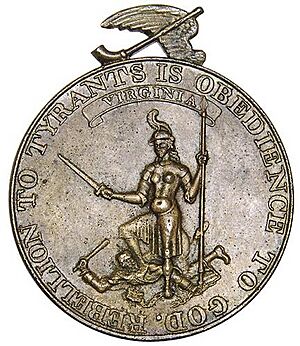
Contents
- Virginia's First People: Prehistory
- Early European Explorers
- Virginia Becomes a Royal Colony
- Religion in Colonial Virginia
- Virginia and the American Revolution
- Early Republic and Antebellum Periods
- Virginia in the Civil War
- Reconstruction in Virginia
- The Gilded Age in Virginia
- The Progressive Era
- Between the World Wars
- World War II and Modern Era
- Virginia Today
- Virginia History on Stamps
- Images for kids
- See also
Virginia's First People: Prehistory
For thousands of years, different groups of indigenous peoples lived in the area we now call Virginia. Scientists have found evidence of settlements dating back to about 6500 BCE.
At the end of the 1500s, the native people of Virginia belonged to three main language groups. The largest group was the Algonquian, with over 10,000 people living along the coast. Further inland were the Iroquoian (about 2,500 people) and the Siouan groups.
Many Algonquian tribes, like the Pamunkey and Chickahominy, were part of the Powhatan Confederacy. This was a powerful group led by a chief named Wahunsunacock. He united about thirty tribes, controlling much of eastern Virginia. This alliance helped protect some tribes from other groups like the Monacan.
Early European Explorers
After discovering the "New World" in the 1400s, European countries like England, France, and Spain wanted to start colonies.
Spanish Explorers in Virginia
In 1540, Spanish explorers led by Juan de Villalobos and Francisco de Silvera searched for gold in what is now Lee County. In 1567, another Spanish group attacked a native village near present-day Saltville. This was the first recorded battle in Virginia's history.
Spanish ships also explored the Chesapeake Bay in 1561. They took two young native men, including Don Luis, back to Spain. In 1570, Spanish missionaries tried to set up a colony called the Ajacán Mission. However, Don Luis and his allies destroyed it in 1571. The Spanish tried to get revenge and explored the area more, but they never tried to build another colony after that.
English Attempts to Settle
The Roanoke Colony was the first English attempt to settle in the New World. It was in what is now North Carolina, but was then part of Virginia. Sir Walter Raleigh sponsored two groups of settlers between 1584 and 1587. Both attempts failed. The last group, known as "The Lost Colony," disappeared completely. This happened after supplies from England were delayed for three years due to a war with Spain.
The name "Virginia" came from information gathered by Raleigh's explorers. They heard a local chief ruled a land called Wingandacoa. Queen Elizabeth I changed the name to "Virginia," perhaps because she was known as the "Virgin Queen."
The Virginia Company of London
After Queen Elizabeth I died in 1603, King James I took the throne. England needed money, so he gave the job of colonizing the New World to the Virginia Company. This was a company where many people invested their money. They hoped to find gold, create a base to attack Spanish ships, and spread Protestantism.
The Virginia Company had two main parts: the Plymouth Company for the northern area and the London Company for the southern area.
Jamestown: The First Permanent English Settlement
The First Landing and Choosing a Spot
In December 1606, the London Company sent 104 colonists on three ships: the Susan Constant, Godspeed, and Discovery. They arrived in Virginia on April 26, 1607, at the entrance to the Chesapeake Bay. At Cape Henry, they landed, put up a cross, and explored a little. This event is called the "First Landing."
They were told to find a place inland, away from Spanish attacks. So, they explored the Hampton Roads area and sailed up the James River to what would become the cities of Richmond and Manchester.
After weeks of searching, the colonists chose a spot and founded Jamestown on May 14, 1607. They named it after King James I. The location on Jamestown Island was good for defense against ships. However, it was a low, marshy area with little drinking water, few animals to hunt, and not much space for farming. Soon after they arrived, the local Paspahegh tribe attacked them.
Early Struggles and John Smith
The colonists were not ready to take care of themselves. They planned to trade with Native Americans for food and relied on supplies from England. They also hoped to find gold. Captain Christopher Newport returned to England with two ships, leaving the Discovery behind. He came back twice in 1608 with more supplies.
Trading with Native Americans was difficult, and many colonists died from disease, hunger, and fights with the natives. After several leaders failed, Captain John Smith took charge. Many people say he saved the colony in its early years. He was good at trading for food and keeping the colonists hopeful.
After Smith returned to England in August 1609, supplies were delayed. During the winter of 1609-1610, no ships arrived. The colonists faced a terrible time known as the "starving time". They were so hungry that some resorted to eating leather from their clothes. When the new governor, Sir Thomas Gates, arrived in May 1610, over 80% of the 500 colonists had died.
Tobacco Saves the Colony
The Virginia Company changed its rules in 1609, giving more power to the governor, Thomas West, 3rd Baron De La Warr. He arrived in June 1610 with 150 men and many supplies. De La Warr started the First Anglo-Powhatan War against the natives. During this time, Samuel Argall kidnapped Pocahontas, Chief Powhatan's daughter.
The colony's economy was a big problem because no gold was found. All attempts to start profitable businesses failed until John Rolfe introduced new types of tobacco from other countries. These tobaccos tasted better than the local kind. When the first shipment went to England in 1612, people loved it. Tobacco became a "cash crop" and made Virginia economically successful.
The First Anglo-Powhatan War ended when John Rolfe married Pocahontas in 1614.
Plantations and the Start of Slavery
George Yeardley became Governor of Virginia in 1619. He ended one-person rule and created the General Assembly. This was the first elected government in the New World.
Also in 1619, the Virginia Company sent 90 single women to be wives for the male colonists. This helped the settlement grow. That same year, a group of "twenty and odd" Africans arrived, brought by English privateers. They were likely the first Africans in the colony. They, along with many European indentured servants, helped grow the tobacco industry. Although these first Africans were treated like indentured servants, this marked the beginning of slavery in America.
Some colonists were given their own land, which encouraged them to work harder and produce more. This was especially true at Thomas Dale's settlement of Henricus.
The colonists were very focused on individual success and making money quickly. This meant they didn't always work together to protect themselves from Native Americans, which led to two major attacks.
Conflicts with Native Americans
English settlers and Native Americans soon had conflicts. They disagreed about land ownership and resources. Virginia often had droughts, and the colonists didn't understand that the natives couldn't always feed them during these hard times. After 1612, colonists cleared more land to grow tobacco. Tobacco used up the soil quickly, so they constantly needed new land. This reduced the forests that Native Americans relied on for hunting.
The tribes tried to stop the colonists from taking their land. Major conflicts happened in 1622 and during the Second Anglo-Powhatan War. Both were led by Chief Opechancanough, Chief Powhatan's younger brother. By the mid-1600s, the Powhatan tribes had fewer people. This was mostly because of new diseases like smallpox and measles, which they had no protection against. The European colonists expanded their territory, controlling almost all the land east of the fall line on the James River.
On March 22, 1622, the Powhatan killed about 400 colonists in what is known as the Indian Massacre of 1622. They attacked almost all English settlements along the James River. At Jamestown, an Indian boy named Chanco warned his employer, Richard Pace, which helped save some lives. Pace warned Jamestown, allowing them to prepare defenses. However, many other settlements were destroyed, and people were killed or captured.
Even with these losses, two-thirds of the colonists survived. The English fought back against the Powhatan. After about a year, they made a truce. The colonists invited the chiefs to Jamestown and poisoned their drinks, killing about 200 men. They killed another 50 Indians by hand.
By the Treaty of 1646, the colonists had gained control of the land between the York and Blackwater Rivers.
Virginia Becomes a Royal Colony
In 1624, the Virginia Company's charter was canceled. Virginia became a crown colony, meaning it was directly controlled by the King of England. However, the elected representatives in Jamestown still had some power. Under royal rule, the colony began to expand north and west.
In 1634, the King created a new local government system. Eight areas called "shires" were set up, each with its own officers. These shires were renamed "counties" a few years later.
Governor Berkeley and the English Civil War
Governor William Berkeley led the first major explorations into the land beyond the Allegheny Mountains. Exploration was slowed in 1644 when about 500 colonists were killed in another Native American attack, again led by Opechancanough. Berkeley tried to find other ways for the colony to make money besides tobacco, like growing mulberry trees for silkworms.
During the 1644 attack, Chief Opechancanough was captured. While imprisoned, one of his guards murdered him. After his death, the remaining Powhatan tribes had to agree to the settlers' demands.
Most Virginia colonists supported King Charles I during the English Civil War. But in 1652, Oliver Cromwell sent forces to remove Governor Berkeley. He was replaced by Governor Richard Bennett, who supported Cromwell's government. Bennett was a moderate Puritan who let the local legislature have most of the power. Many royalists who lost the English Civil War fled to Virginia. Some married into important Virginia families like the Washingtons and Lees. After the King returned to power, King Charles II of England called Virginia "The Old Dominion" because of its loyalty.
Bacon's Rebellion
Governor Berkeley became popular again after Cromwell's rule ended. However, his second time as governor had many problems. Virginia faced diseases, hurricanes, Native American attacks, and economic troubles. Berkeley became very powerful and refused to hold new elections for the legislature for 14 years. He only agreed to new elections when a rebellion became a serious threat.
In 1676, Nathaniel Bacon led a rebellion. Native Americans had been attacking settlers who were moving into their lands. When settlers fought back against the wrong tribe, the violence grew. Berkeley refused to help the settlers. Many believed this was because he had invested in the fur trade, and fighting would hurt his business. Bacon organized his own group of settlers to fight the Native Americans.
Bacon became very popular as he opposed Berkeley on many issues. Berkeley called Bacon a rebel, but later pardoned him when Bacon won a seat in the legislature. However, when Berkeley didn't make reforms, Bacon openly rebelled. He captured Jamestown and controlled the colony for several months. This event is known as Bacon's Rebellion. Berkeley got his power back with help from the English military. Bacon burned Jamestown before leaving, but then died of disease. Berkeley severely punished the remaining rebels.
Because Berkeley was so harsh, the English government removed him from office. After Jamestown burned, the capital was temporarily moved to Middle Plantation.
Building Williamsburg
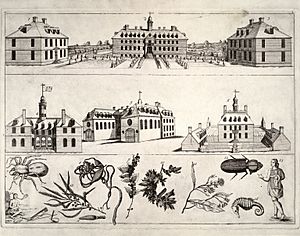
Local leaders wanted a college for the sons of planters and for educating Native Americans. An earlier attempt to build a university at Henricus failed after the 1622 attack. Seventy years later, Reverend Dr. James Blair, Virginia's top religious leader, made a new plan. He went to England and in 1693, got a charter from King William and Queen Mary II of England. The college was named the College of William and Mary in their honor.
The statehouse in Jamestown burned again in 1698. After that fire, the colonial capital was permanently moved to nearby Middle Plantation. The town was renamed Williamsburg in honor of the king. Plans were made to build a new capitol building and design the new city.
Tobacco Plantations and Society
As more English people used tobacco, growing tobacco in the American colonies became very important for the economy, especially in the tidewater region around the Chesapeake Bay. Huge plantations were built along Virginia's rivers. To grow and sell this "cash crop," they brought in and used enslaved people. Planters would pack tobacco into large barrels and send them to warehouses. In 1730, Virginia passed a law to make sure tobacco quality was good.
White society in Virginia had different levels. The richest 5% were planters who had a lot of wealth and power. They controlled the local church and held important government jobs. About 60% of white Virginians were middle-class farmers with their own land. The poorest third owned no land and were often new arrivals or recently freed indentured servants.
Sports were very popular. Unlike England, where hunting was only for landowners, in America, everyone could hunt. Horse racing was a major event, especially for rich gentlemen. It was a way for them to show off their wealth and status through expensive horses, training, and gambling.
Historians believe that by the 1650s, Virginians used slavery and racial divisions to avoid conflicts between different social classes of white people. This meant white men became more equal to each other because there was a large group of low-status enslaved people.
By 1700, Virginia's population reached 70,000 and grew quickly. This was due to a high birth rate, low death rate, and people moving from Britain, Germany, and Pennsylvania. The climate was mild, and farmland was cheap and fertile.
Moving West: Early to Mid-1700s

In 1716, Governor Alexander Spotswood led an expedition that reached the top of the Blue Ridge Mountains. He also encouraged German immigrants to settle at Germanna to produce iron.
By the 1730s, a road called the Three Notch'd Road stretched from the James River to the Shenandoah Valley. Around this time, Governor William Gooch encouraged people to settle in Virginia's western areas. This was to protect the colony from Native American and French settlements. Many settlers, including Germans and Scotch-Irish immigrants, traveled south on the Great Wagon Road from Pennsylvania. By 1735, there were 160 families in the backcountry, and within ten years, nearly 10,000 Europeans lived in the Shenandoah Valley.
As colonists moved into the piedmont area, there were questions about land ownership. Thomas Fairfax, 6th Lord Fairfax of Cameron owned a large area called the Northern Neck Proprietary. He visited Virginia between 1735 and 1737 to check on his lands. He hired a young George Washington to survey his lands west of the Blue Ridge Mountains. After these land issues were settled, Frederick County, Virginia was founded in 1743. Its main settlement, "Frederick Town," became the city of Winchester, Virginia in 1752.
In the late 1740s, the British and French fought for control of the Ohio Country. Virginians like Thomas Lee and the Washington brothers formed the Ohio Company to represent Virginia's interests. In 1749, the British Crown gave the Ohio Company a lot of land if British colonists settled it. Governor Robert Dinwiddie of Virginia, who was an investor in the Ohio Company, ordered 21-year-old Major George Washington to tell the French to leave Virginia territory. This led to the French and Indian War (1754–1763).
After the war, the Royal Proclamation of 1763 stopped British settlement past a line along the Appalachian Mountains. This land was called the Indian Reserve. British colonists and land investors didn't like this rule because they already had land grants beyond the line. Many settlements already existed there. For example, George Washington and his soldiers had been given land past the boundary. People lobbied the government to move the line further west. They succeeded, and the boundary was adjusted through treaties with Native Americans, opening up much of what is now Kentucky and West Virginia to settlement.
Religion in Colonial Virginia

The Church of England was the official church in Virginia starting in 1619. This meant local taxes helped pay for the church and local government needs like roads and helping the poor. There was no bishop in colonial Virginia. Instead, local church leaders, who were wealthy laymen, controlled the church. By the 1740s, there were about 70 Anglican priests in the colony.
Missionaries tried to convert Native Americans, but they had little success except with the Nansemond tribe. Other Powhatan tribes converted to Christianity around 1791.
The First Great Awakening in the mid-1700s emphasized personal faith. This drew people away from the formal church. In the backcountry, many families had no religious ties. Baptists, Methodists, and Presbyterians challenged these relaxed moral standards. They paid their own ministers and wanted the Anglican church to no longer be the official state church.
The preacher Samuel Davies led the Presbyterians and converted many enslaved people. By the 1760s, Baptists attracted many Virginians, especially poor white farmers, to a new, more democratic religion. Enslaved people were welcome at services, and many became Baptists. Methodist missionaries also worked in the late colonial period. Methodists encouraged ending slavery and welcomed free blacks and enslaved people into their churches.
Baptists and Presbyterians faced many legal restrictions. Between 1768 and 1774, about half of Virginia's Baptist ministers were jailed for preaching. This was despite England's Act of Toleration of 1689, which allowed Protestants to worship freely. At the start of the American Revolution, Anglican leaders realized they needed the support of these groups. They met most of their demands in exchange for their help in the war.
After the American victory, the Anglican church in Virginia was no longer the official state church. It became the Episcopal Church in the United States, with no ties to Britain. Thomas Jefferson and James Madison helped pass the Virginia Statute for Religious Freedom in 1786, which guaranteed freedom of religion.
Virginia and the American Revolution
Causes of the Revolution
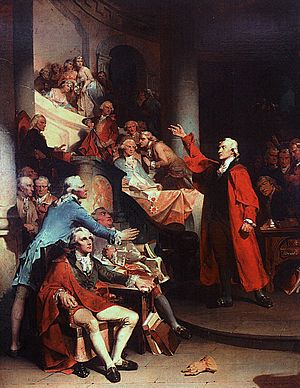
Ideas about revolution started appearing in Virginia after the French and Indian War ended in 1763. The British government had a lot of debt from its wars. To pay it off, Parliament passed the Sugar Act in 1764 and the Stamp Act in 1765. Virginia's government opposed the Sugar Act, saying there should be "no taxation without representation". They passed the "Virginia Resolves" against the Stamp Act. Governor Francis Fauquier responded by closing the Assembly.
The Stamp Act was canceled, but new taxes and attempts to send Boston protesters to London for trial caused more protests in Virginia. The Assembly met to condemn these actions, but Governor Lord Botetourt dissolved the legislature. The members then met in a tavern and agreed to stop buying British goods. Britain eventually removed all taxes except the one on tea in 1770.
In 1773, because of another attempt to send Americans to Britain for trial, Virginia leaders like Richard Henry Lee, Thomas Jefferson, Patrick Henry, and George Mason created a committee to deal with problems with Britain. This committee was important for Virginia's role in the American Revolution.
After the Virginia government showed support for Massachusetts, Governor Lord Dunmore again dissolved the legislature. The first Virginia Convention met in August to respond to the growing crisis. They approved a boycott of British goods and chose delegates to the Continental Congress.
War Begins in Virginia
On April 20, 1775, Dunmore ordered gunpowder removed from Williamsburg to a British ship. Patrick Henry led a group of Virginia militia in response. Carter Braxton helped resolve the Gunpowder Incident by arranging for royal funds to pay for the powder. This incident made Dunmore even less popular. He fled the Governor's Palace to a British ship. On November 7, Dunmore declared Virginia was in rebellion. By this time, George Washington was leading the American forces, and Virginia was led by a Committee of Safety.
On December 9, 1775, Virginia militia fought the governor's forces at the Battle of Great Bridge, winning a small victory. Dunmore responded by attacking Norfolk with his ships on January 1, 1776. After the Battle of Great Bridge, there was little fighting in Virginia for a while. However, Virginia sent forces to help in battles in the North, South, and on the western frontier.
Declaring Independence
The Fifth Virginia Convention met on May 6 and declared Virginia a free and independent state on May 15, 1776. They told their delegates to propose independence at the Continental Congress. Richard Henry Lee introduced the idea on June 7. While Congress debated, the Virginia Convention adopted George Mason's Bill of Rights (June 12) and a constitution (June 29). This constitution created an independent state government. Congress approved Lee's proposal on July 2 and Jefferson's Declaration of Independence on July 4. The new Virginia constitution created a two-part legislature with a House of Delegates and a Senate. Patrick Henry became the first Governor of the Commonwealth.
War Returns to Virginia
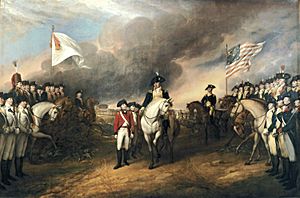
The British brought the war back to Virginia's coast in May 1779. Fearing Williamsburg was unsafe, Governor Thomas Jefferson moved the capital inland to Richmond in 1780. However, in December, Benedict Arnold, who had joined the British, attacked Richmond and burned part of the city.
Arnold moved his base to Portsmouth. General William Phillips joined him and destroyed military and economic targets. Virginia's defenses, led by General Baron von Steuben, fought back but had to retreat. The French General Lafayette arrived to help defend Virginia. He fought British forces led by General Charles Cornwallis in several small battles. Cornwallis sent two groups to Charlottesville to capture Governor Jefferson and the legislature, but Jack Jouett rode to warn them.
Cornwallis moved his troops to Yorktown. General Washington and his French ally Rochambeau moved their forces from New York to Virginia. The French navy, led by Admiral de Grasse, defeated the British navy at the Battle of the Virginia Capes. This meant Cornwallis could not get supplies or escape by sea. After a two-week siege to Yorktown, Cornwallis surrendered on October 19.
This defeat led the British king to lose control of Parliament. The new British government offered peace in April 1782. The Treaty of Paris of 1783 officially ended the war.
Early Republic and Antebellum Periods
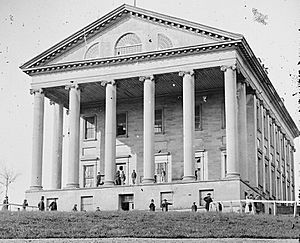
Winning the Revolution brought peace and success to Virginia. European markets reopened for its tobacco.
Younger war veterans wanted a stronger national identity. Led by George Washington and James Madison, Virginia played a big role in the Constitutional Convention of 1787 in Philadelphia. Madison proposed the Virginia Plan, which would give states representation in Congress based on their total population, including a portion of enslaved people. Virginia was the most populated state. It was allowed to count all its white residents and 3/5 of its enslaved African Americans for its representation in Congress and its electoral votes. Only white men who owned property could vote.
The Constitution was approved after people promised to add a Bill of Rights. Virginia approved the Constitution on June 25, 1788, becoming the tenth state to join the United States.
Madison was important in the new Congress, and Washington was chosen as the first president. After him, three more Virginians became president: Thomas Jefferson, Madison, and James Monroe. This was known as "The Virginia Dynasty."
Slavery and Free African Americans
The Revolution brought changes for enslaved African Americans. Thousands escaped to British lines and gained freedom during the war. Many left with the British to live in other colonies or England.
Inspired by the Revolution, many slaveholders in Virginia freed some or all of their enslaved people. The number of free African Americans in Virginia grew from 1,800 in 1782 to over 30,000 in 1810. One planter, Robert Carter III, freed over 450 enslaved people. George Washington freed all of his enslaved people after his death.
Many free African Americans moved from farms to cities like Petersburg and Richmond to find jobs and build communities. Others moved to the frontier where rules were less strict.
Two slave rebellions happened in Virginia: Gabriel's Rebellion in 1800 and Nat Turner's Rebellion in 1831. White people reacted harshly, and militias killed many innocent free blacks and enslaved people. After Nat Turner's Rebellion, laws were passed that limited the rights of free African Americans. They couldn't carry weapons, serve in the militia, get an education, or gather in groups.
Moving West from Virginia

As the United States grew, Virginia's role changed. Its large colonial lands were divided into other states and territories. In 1792, three western counties split off to form Kentucky.
Virginia's soil became less fertile after 200 years of tobacco farming. Many Virginians moved west to find more fertile land. The Louisiana Purchase in 1803 sped up this movement. Many famous Americans who explored and settled the American West were from Virginia, like Meriwether Lewis and William Clark of the Lewis and Clark Expedition.
Differences Between Eastern and Western Virginia
As western Virginia developed in the early 1800s, big differences appeared between the eastern and western parts of the state. In eastern Virginia, slavery was important to the economy. Planters still owned many enslaved people, even as they shifted from tobacco to other crops. In western Virginia, families had smaller farms, mostly without enslaved labor. People there also mined minerals and harvested timber.
Representation in the state government favored the more populated eastern areas. This was made worse because enslaved people were counted for population, even though they couldn't vote. This gave more power to white men in the east. The state tried to fix these differences, but it didn't work. So, when the Civil War began, Virginia was already divided internally. Virginia was the only state to split into two separate states during the war.
New Roads, Canals, and Industries
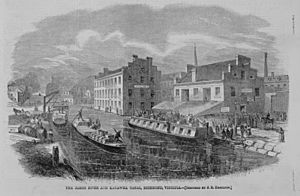
After the Revolution, Virginia started building new transportation projects. These included the Dismal Swamp Canal, the James River and Kanawha Canal, and various turnpikes (toll roads). Virginia also had the first federal infrastructure project under the new Constitution, the Cape Henry Light lighthouse, built in 1792. After the War of 1812, several national defense projects were built in Virginia, like Drydock Number One in Portsmouth (1827) and Fort Monroe (1834).
In the 1830s, railroads began to be built. The Chesterfield Railroad started hauling coal in 1831. The first railroad with locomotives was the Richmond, Fredericksburg and Potomac Railroad, started in 1834. Other railroads followed, connecting different parts of the state. In 1849, the Blue Ridge Railroad successfully crossed the Blue Ridge Mountains through the Blue Ridge Tunnel.
Petersburg became a manufacturing center. Many free African American artisans and craftsmen lived there. By 1860, half of Petersburg's population was black, and one-third of them were free.
Virginia was a leader in the iron industry because it had a lot of iron deposits. The first ironworks in the New World was at Falling Creek in 1619. Eventually, there were 80 ironworks, using about 7,000 workers, 70% of whom were enslaved. Enslaved workers were cheaper and easier to control than white workers. However, their work ethic was often weak because they didn't get paid and were treated poorly. Virginia's iron industry fell behind other states that used free labor.
Virginia in the Civil War

Virginia first refused to join the Confederacy. But after President Lincoln asked for troops from all states, Virginia voted to leave the Union on April 17, 1861. Voters approved this decision on May 23. The Union Army immediately moved into northern Virginia and captured Alexandria.
Because of its important location, the Confederacy moved its capital to Richmond. Richmond was a major target for Union attacks. It was also a center for iron production at Tredegar Iron Works, which made most of the artillery for the war. The city had many army hospitals. Libby Prison for Union officers became known for its harsh conditions. Richmond's main defenses were trenches around it and the nearby city of Petersburg. Saltville was a key source of salt for the Confederacy, leading to two battles there.
The first major battle of the Civil War happened on July 21, 1861. Union forces tried to take control of the railroad junction at Manassas. But the Confederate Army got there first and won the First Battle of Manassas.
Men from all backgrounds joined both sides. Areas in western Virginia, with fewer enslaved people and a history of disagreeing with eastern Virginia, sent fewer men to the Confederacy.
West Virginia Becomes a State
The western counties of Virginia did not support the Confederacy. They broke away and formed the Union state of Virginia, known as the Restored Government of Virginia. This government was based in Alexandria. From May to August 1861, Unionist meetings in Wheeling formed a new government. They declared Virginia was still in the Union and elected a new governor, Francis H. Pierpont. This government was recognized by President Lincoln. On August 20, they voted to create a new state, West Virginia. Voters approved this on October 24. West Virginia became the 35th state on June 20, 1863. So, during the war, there were three Virginias: Confederate Virginia, Union Restored Virginia, and West Virginia.
The Confederate government in Richmond did not recognize the new state. Confederate forces, led by Robert E. Lee, tried to fight the Union forces in West Virginia but were defeated. The Union controlled the region west of the Alleghenies and the Baltimore and Ohio Railroad.
Later Years of the War
Many major battles were fought across Virginia throughout the rest of the war. These included the Seven Days Battles, the Battle of Fredericksburg, and the Battle of Chancellorsville.
Over time, the Confederacy lost control of many parts of Virginia. By October 1862, northern Virginia was under Union control. The Eastern Shore and other coastal areas were also permanently occupied by the Union. Other regions, like the Piedmont and Shenandoah Valley, changed hands many times.
In 1864, the Union Army attacked Richmond directly. This led to the Siege of Petersburg, which lasted from summer 1864 to April 1865. By November 1864, Confederate forces only controlled a small area around Richmond and Petersburg.
In April 1865, the retreating Confederate Army burned Richmond. Lincoln walked through the city streets, greeted by cheering crowds of newly freed African Americans. The Confederate government fled south. The war ended when Lee surrendered to Ulysses Grant at Appomattox on April 9, 1865.
Reconstruction in Virginia
Virginia was badly damaged by the war. Railroads were ruined, many plantations were burned, and many people were refugees without jobs or food. The Union Army's Freedmen's Bureau provided some supplies.
After the war, President Andrew Johnson recognized the government led by Francis Harrison Pierpont. The Virginia legislature passed "Black Codes" that greatly limited the rights of freed African Americans. They had limited rights, were not considered citizens, and could not vote. Virginia ratified the 13th Amendment to end slavery and canceled its 1861 secession order. Johnson thought Reconstruction was complete.
However, Republicans in Congress refused to accept Virginia's new representatives. They wanted more proof that slavery was truly abolished and that freedmen had full citizen rights. They also worried that Virginia's leaders still supported the Confederacy. After winning many elections in 1866, the Radical Republicans gained power in Congress. They put Virginia (and nine other former Confederate states) under military rule. Virginia was called the "First Military District" from 1867–69, led by General John Schofield.
Freed African Americans became politically active. They joined the Union League, held meetings, and demanded that all men could vote and have equal rights. They also wanted to prevent former Confederates from voting or holding office and to take their plantations.
A deep split formed among Republicans. Moderates, called "True Republicans," had national support. Radicals wanted to prevent more white people from voting, such as former Confederate soldiers, and wanted land reform. About 20,000 former Confederates could not vote in the 1867 election. In 1867, James Hunnicutt, a white preacher, encouraged black Republicans to vote. He called for taking all plantations and giving the land to freedmen and poor whites. The "True Republicans" supported black suffrage but not taking property. Hunnicutt's group took control of the Republican Party and demanded that all whites who supported the Confederacy be permanently prevented from voting. The Virginia Republican party split, and many moderate Republicans joined the "Conservatives." The Radicals won the 1867 election for delegates to a constitutional convention.
The 1868 constitutional convention included 33 white Conservatives and 72 Radicals (24 Black, 23 Scalawag, and 21 Carpetbaggers). This "Underwood Constitution" reformed the tax system and created free public schools for the first time in Virginia. After much debate about preventing Confederates from holding office, the Virginia legislature approved a Constitution that did not allow ex-Confederates to hold office, but let them vote in state and federal elections.
General Schofield continued to lead the state through the Army. He appointed Henry H. Wells as provisional governor. Schofield and Wells fought against Hunnicutt and the Scalawag Republicans. In 1869, elections were held for state officials and on the new constitution. The Army registered freedmen as voters but did not allow about 20,000 important white people to vote or hold office. The Republicans nominated Wells for governor.
The leader of the moderate Republicans, William Mahone, was a railroad president and former Confederate general. He formed a group of white Scalawag Republicans, some black people, and former Democrats who formed the Conservative Party. Mahone believed whites had to accept the war's results, including civil rights and voting rights for freedmen. Mahone's plan worked. In 1869, voters elected Gilbert C. Walker as governor and defeated the plan to prevent ex-Confederates from voting.
When the new legislature approved the 14th and 15th Amendments to the U.S. Constitution, Congress accepted Virginia's representatives. Virginia's Reconstruction ended in January 1870. The Radical Republicans were removed from power peacefully. Virginia was the only southern state that did not elect a government based on more Radical Republican ideas. White Virginians generally felt bitter after the war due to the destruction and challenges of adapting to free labor.
The Gilded Age in Virginia
Railroads and Industry Grow
After the Civil War, new railroads were built and old ones rebuilt. In 1868, the Virginia Central Railroad became the Chesapeake and Ohio Railroad. In 1870, several railroads merged to form the Atlantic, Mississippi and Ohio Railroad, later called Norfolk & Western. The Richmond and Allegheny Railroad was built on an old canal path. Other railroads like the Southern Railroad and the Seaboard Air Line also came to Virginia.
In the 1880s, the Pocahontas Coalfield opened in southwest Virginia, creating more demand for railroads to transport coal. The growth of railroads led to new towns and fast growth in others, like Clifton Forge and Roanoke.
With the invention of the cigarette rolling machine, smoking became very popular. Cigarettes and other tobacco products became a major industry in Richmond and Petersburg. Wealthy tobacco leaders like Lewis Ginter funded many public institutions.
Politics, Education, and Segregation
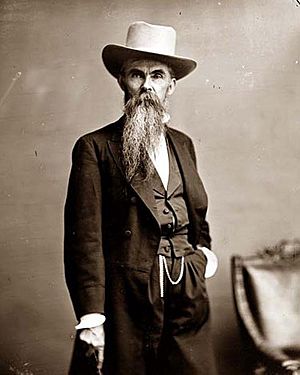
A political disagreement happened in Virginia in the 1870s. Some politicians, called "Readjusters," wanted to reduce Virginia's pre-war debt. Others, called "Funders," believed Virginia should pay all its debt. Virginia's debt was mostly for transportation projects, many of which were destroyed in the war or were now in West Virginia.
William Mahone, a former Confederate General and railroad executive, became the leader of the "Readjusters." He formed a group of Democrats, white Republicans, and black Republicans. The Readjusters wanted to "break the power of wealth" and improve public education. They promised to "readjust" the state debt to protect money for new public schools and make sure West Virginia paid its fair share. Their idea to remove the poll tax (a fee to vote) and increase school funding attracted support from both white and black people.
The Readjuster Party successfully elected William E. Cameron as governor (1882-1886). Mahone also served as a Senator in the U.S. Congress. The Readjusters controlled Virginia politics until 1883.
After the Readjuster Party faded, Virginia Democrats quickly passed laws and constitutional changes that prevented African Americans and many poor whites from voting. They used poll taxes and literacy tests. This created white, one-party rule under the Democratic Party for the next 80 years. White state lawmakers passed laws that brought back white supremacy through Jim Crow segregation. In 1902, Virginia passed a new constitution that made it harder to vote.
The Progressive Era

The Progressive Era after 1900 brought many changes to modernize Virginia. These changes aimed to make the state more efficient, use scientific methods, improve education, and stop waste and corruption.
A key leader was Governor Claude Swanson (1906–10). He built schools and highways, raised teacher salaries, improved public health programs, and increased funding for prisons. Swanson fought against child labor, lowered railroad rates, and raised taxes on companies. He also made state services more organized. The state funded a growing network of roads, often built by black prisoners in chain gangs. Swanson's political organization later became the "Byrd Organization."
The State Corporation Commission (SCC) was created in 1902 to regulate railroads. It was independent and worked to benefit the public.
Virginia had a long history of agricultural reformers. During the Progressive Era, they worked to improve rural areas, which had problems like declining populations, many people who couldn't read, poor farming methods, and diseases. Reformers focused on improving elementary education. With federal help, they set up a system that taught farmers the latest scientific methods and helped farm wives manage their homes better.
Some wealthy women, like Lila Meade Valentine, promoted many Progressive reforms. These included kindergartens, teacher training, and vocational education for both races. Middle-class white women were very active in the Prohibition movement (to ban alcohol). The women's suffrage movement (for the right to vote) faced issues with race, as white people were hesitant to let black women vote. Virginia women gained the right to vote in 1920, through a national constitutional amendment.
In higher education, Edwin A. Alderman, president of the University of Virginia, worked to make southern universities centers for state service and intellectual leadership. He helped professionalize and modernize Virginia's higher education system.

While progressives wanted to modernize, there was also a strong interest in Virginia's traditions. The Association for the Preservation of Virginia Antiquities (APVA), founded in 1889, focused on patriotism and Virginia's Founding Fathers. In 1907, the Jamestown Exposition was held near Norfolk to celebrate 300 years since Jamestown was founded.
The Jamestown Exposition also showed the military potential of the area. The exposition site later became the Norfolk Naval Station in 1917. Virginia's location, moderate climate, and large harbor made it a key place for new military bases during World War I. These included Fort Story, Langley, Quantico Marine Base, Fort Belvoir, Fort Lee, and Fort Eustis. Heavy shipping traffic also made the area a target for German submarines.
Between the World Wars
Temperance (the movement to ban alcohol) became important in the early 1900s. In 1916, a statewide vote outlawed alcohol. This ban was overturned in 1933.
After 1930, tourism grew with the development of Colonial Williamsburg.
Shenandoah National Park was created from new land. The Blue Ridge Parkway and Skyline Drive were also built. The Civilian Conservation Corps helped develop the National Park and Pocahontas State Park. By 1940, new highway bridges crossed major rivers, ending long-distance steamboat service.
The Byrd Machine
African Americans made up a third of the population but lost almost all their political power. From 1905 to 1948, government employees and officeholders cast a third of the votes in state elections. This small, controlled group of voters helped Harry Byrd (1887–1966) create a powerful statewide political organization, known as the "Byrd machine." It controlled Virginia from the 1920s to the 1960s. Most African Americans who remained politically active supported the Byrd organization. This helped Virginia have more peaceful race relations than other Southern states before the 1950s. African Americans did not fully regain their voting rights until federal civil rights laws were passed in 1964 and 1965.
World War II and Modern Era

The economic boost from World War II brought full employment, high wages, and high profits for farmers. Many soldiers and sailors came to Virginia for training. Virginia sent 300,000 men and 4,000 women to serve in the military. The war greatly increased the state's naval and industrial economy. Federal government jobs also grew in Northern Virginia and Washington, D.C. The Pentagon was built in Arlington as the world's largest office building. New military bases like Fort A.P. Hill and Fort Pickett opened, and Fort Lee was reactivated. The Newport News shipyard increased its workers from 17,000 to 70,000 by 1943.
The Cold War and Space Age

After the war, the Cold War led to more growth in Northern Virginia and Hampton Roads. The Central Intelligence Agency (CIA) built its headquarters in Langley. In the early 1960s, the new Dulles International Airport was built. Other sites like the listening station at Vint Hill were also important. The U.S. Atlantic Fleet was in Norfolk, and in 1952, the Allied Command Atlantic of NATO was headquartered there. Later, Newport News Shipbuilding began building the USS Enterprise, the world's first nuclear-powered aircraft carrier.
Virginia also played a role in the Space Race. When the National Advisory Committee for Aeronautics became NASA in 1958, the Space Task Group was based at Langley Research Center. From there, they started Project Mercury, the first U.S. manned spaceflight program. On the Eastern Shore, Wallops Flight Facility was a rocket launch site.
The new U.S. Interstate highway system, started in the 1950s, and the new Hampton Roads Bridge-Tunnel in 1958 helped Virginia Beach grow into one of the state's largest cities. In western Virginia, Interstate 81 brought better access and new businesses. The creation of large lakes by damming rivers, like Smith Mountain Lake, attracted many retirees and vacationers. As the century ended, tobacco farming in Virginia declined. A statewide community college system made higher education more affordable and accessible. New universities like George Mason University and Liberty University were founded. Some manufacturing towns like Danville and Martinsville faced difficulties as their industries closed.
Massive Resistance and Civil Rights
In 1944, Irene Morgan refused to give up her seat on an interstate bus in Middlesex County, Virginia. She was arrested. Morgan appealed her case to the Supreme Court and won in 1946. The ruling, Irene Morgan v. Commonwealth of Virginia, made segregation on interstate buses illegal. Virginia continued to enforce bus segregation. In 1947, activists organized "Journey of Reconciliation" rides through Virginia and other Southern states to protest this. Another Supreme Court ruling, Boynton v. Virginia, desegregated interstate bus terminals. These cases inspired the 1961 Freedom Rides that fought bus segregation in the Deep South. Another Supreme Court case involving Virginia, Loving v. Virginia, made laws against interracial marriage illegal.
Virginia's state government strongly resisted federal orders to end segregation. The state legislature even passed laws, known as the Stanley plan, to try to avoid racial integration in public schools. Prince Edward County even closed all its public schools to avoid integration, but eventually gave in after Supreme Court rulings. The first black students attended the University of Virginia School of Law in 1950 and Virginia Tech in 1953. In 2008, the Virginia Civil Rights Memorial was built in Richmond to remember actions of the Civil Rights Movement.
Virginia Today
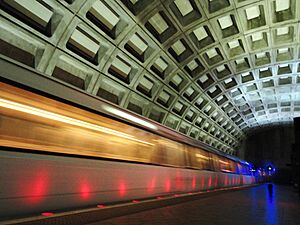
By the 1980s, Northern Virginia and the Hampton Roads region had grown the most. This was mainly due to jobs related to federal government agencies and defense, as well as new technology in Northern Virginia. Shipping through the Port of Hampton Roads expanded. The growth of government programs near Washington, D.C., greatly changed Northern Virginia's economy. Its population grew a lot and became very diverse, with communities like Tysons Corner and Reston. This growth also led to a local information technology industry. In recent years, heavy traffic and the need for better roads and public transportation have been major issues in Northern Virginia. The Hampton Roads region and the western suburbs of Richmond have also grown a lot.
On January 13, 1990, Douglas Wilder became the first African American elected as Governor of a U.S. state since the Civil War.
Virginia was a major center for information technology in the early days of the Internet. Internet companies gathered in the Dulles Corridor. By 1993, the Washington area had the most Internet connections and providers. In 2000, more than half of all Internet traffic flowed along the Dulles Toll Road. Bill von Meister founded two Virginia companies that helped make the Internet available to everyone: The Source and Control Video Corporation, which later became America Online (AOL). AOL became the largest Internet provider during the time when people connected to the Internet using dial-up modems.
In 2006, former Governor of Virginia Mark Warner gave a speech in the online game Second Life, becoming the first politician to appear in a video game. In 2007, Virginia quickly passed the nation's first spaceflight act. A Northern Virginia company, Space Adventures, is currently the only company offering space tourism. In 2008, Virginia became the first state to pass a law on Internet safety, requiring educational courses for 11- to 16-year-olds.
Virginia was attacked on September 11, 2001. American Airlines Flight 77 was hijacked and crashed into the Pentagon in Arlington County.
In 2013, Virginia elected a governor from the same political party as the U.S. President. This was the first time in over thirty years that the governor and president were from the same party.
Virginia History on Stamps
Stamps showing Virginia events and landmarks include:
- Jamestown founding
- Mount Vernon
- Stratford Hall
Images for kids
-
The U.S. Supreme Court ordered Prince Edward County to integrate its schools in 1964.
See also
 In Spanish: Historia de Virginia para niños
In Spanish: Historia de Virginia para niños


